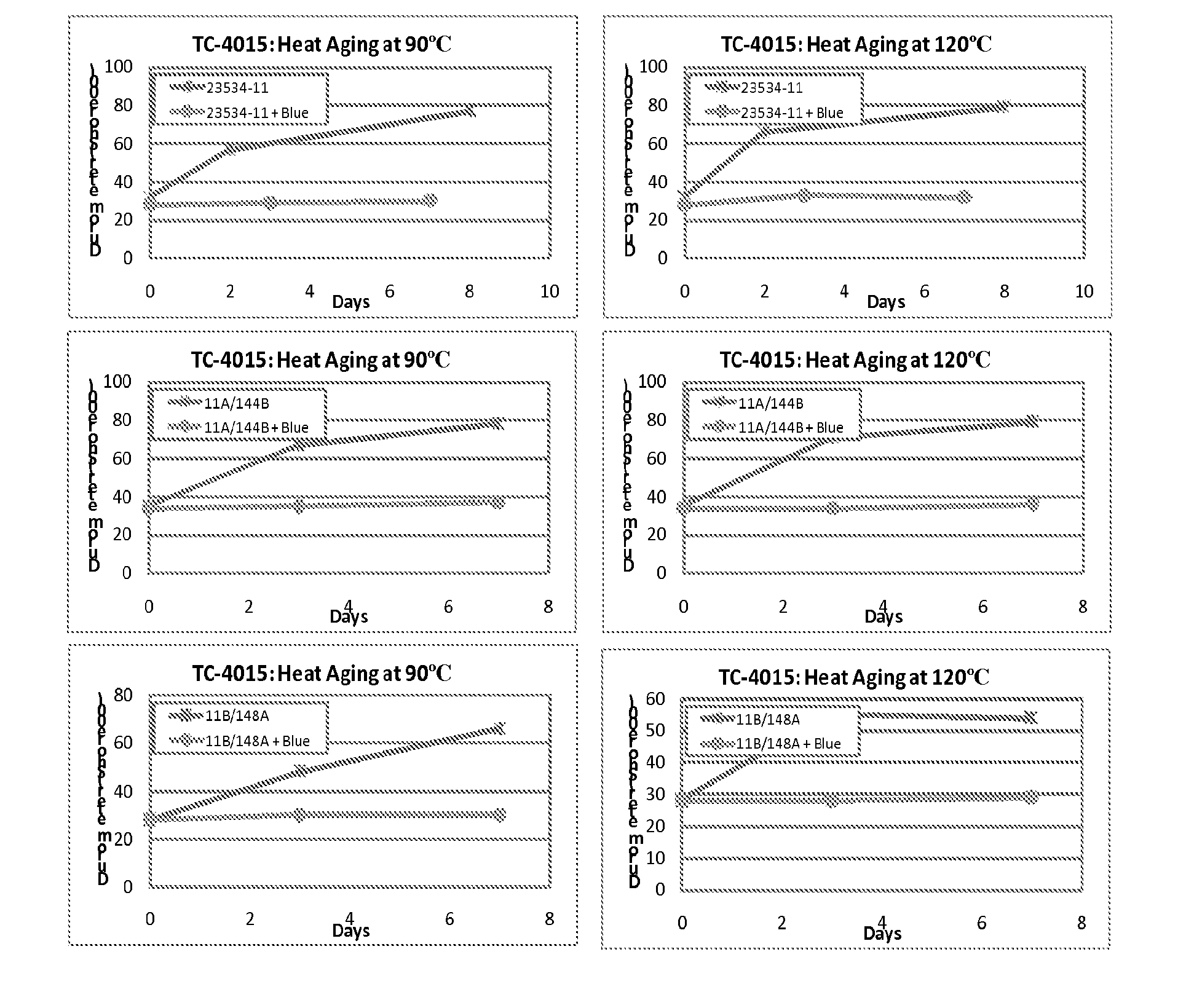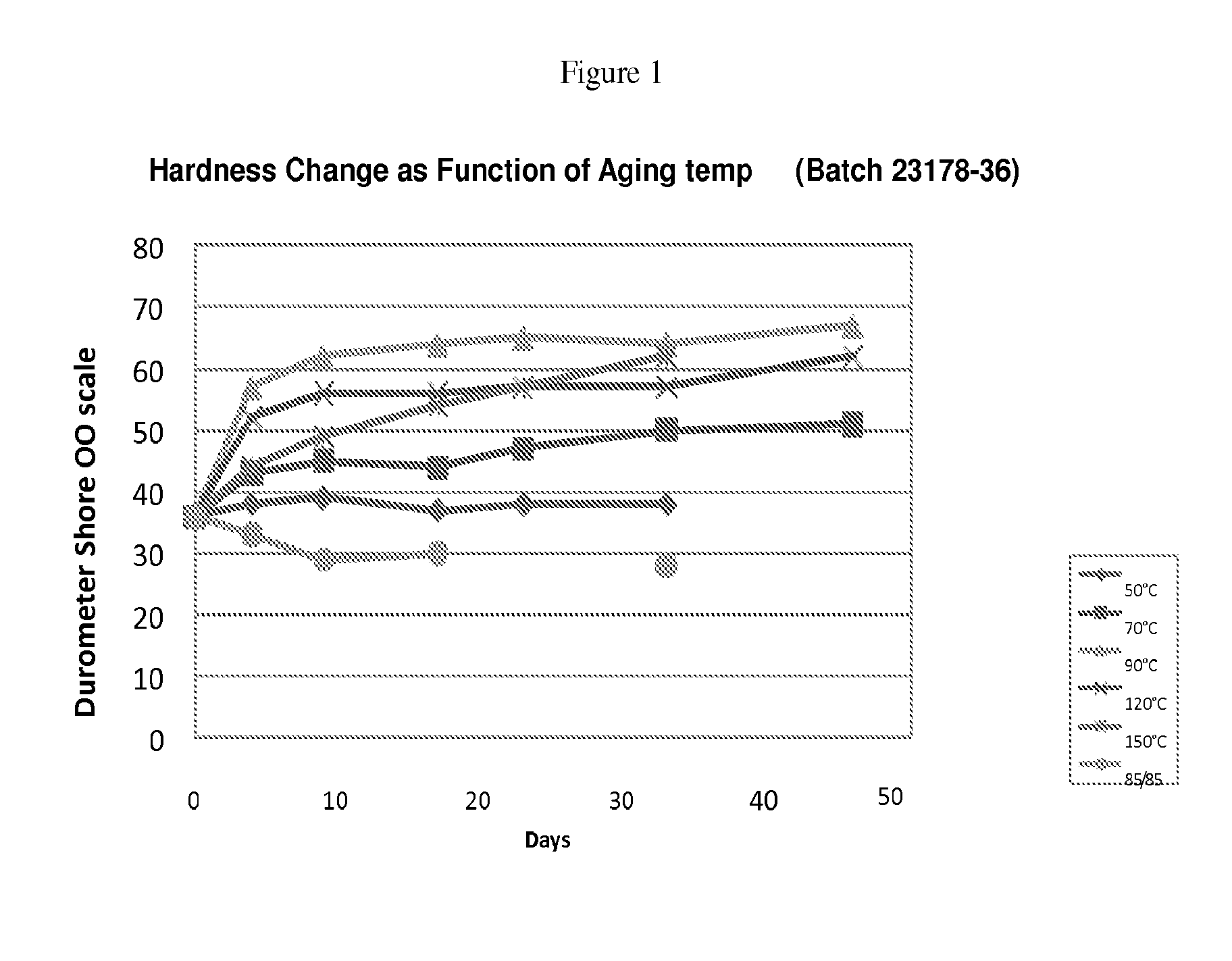High Temperature Stable Thermally Conductive Materials
- Summary
- Abstract
- Description
- Claims
- Application Information
AI Technical Summary
Benefits of technology
Problems solved by technology
Method used
Image
Examples
example 1
[0101]These examples are intended to illustrate the invention to one skilled in the art and should not be interpreted as limiting the scope of the invention set forth in the claims. The following raw materials were used to prepare samples in these examples. Part (a) of the two-part mixture was prepared as by mixing components (A), (C), (D), and (H). Part (b) of the two-part mixture was prepared by mixing components (A), (B), (D), (H), (N), and carbon black pigment to add color. Component (A) was a vinyl-terminated polydimethylsiloxane having a viscosity ranging from 300 to 1000 centiStokes (cSt). Component (B) was a trimethyl terminated poly(dimethyl-hydrogen siloxane) polymer and a dimethylpolysiloxane capped at both molecular terminals with dimethylhydrogensiloxy groups. Component (C) was a mixture of platinum catalyst in silicone fluid. Component (D) was alumina with average particle size of 2 μm. Component (H) was n-octyltrimethoxysilane. 3,5-Dimethyl-1-hexyn-3-ol, was added as ...
example 2
Comparative Result
[0102]The composition of Example 1 was allowed to cure by letting the combined component stand for 60 minutes at 125° C., and the hardness of the cured material was measured and shown according to Durometer Shore Type OO scale (ASTM D 2240). The cured material was then kept in a constant temperature atmosphere for up to 50 days in an oven. The results are shown in FIG. 1, which shows the hardness change of the cured material as a function of aging temperature. The hardness was measured for batch 23178-36 kept at 50 (♦ blue), 70 (▪ brown), 90 ( green), 120 ( purple), and 150 (* light blue) degrees Celsius atmosphere, on day 4, 9, 17, 23, 33, 46 and 100. The cured material was also kept at 85 degrees Celsius and controlled humidity of 85% (, orange, 85 / 85). As seen in FIG. 1, the hardness increased at elevated temperatures over time. Table 1 also shows the data in a numeric form.
Days At TemperatureTemp. (° C.)04917233346100 50° C.36383937383837 70° C.364345444750515...
example 3
[0103]Several batches of the two-part composition samples were prepared as described above, except that 0.08 wt % (relative to the final combined composition) of phthalocyanine copper (0.2% Harwick Stan-Tone™ 40SP03 (PolyOne, Ohio, USA) blue pigment) was added to some samples by mixing it in Part (b) prior to cure. The cured compositions were kept at 90 degrees Celsius and 120 degrees Celsius for up to 37 days. The hardness was measured by Durometer Shore 00 scale on day 3, 7 or 8, 18 or 21, and 34. Table 2a-2b shows the results of batch 23534-11 with and without a phthalocyanine blue pigment.
TABLE 2aSample 23534-11StorageStorage Time at Temperature (Days)Temp02821 90° C.32577778120° C.32667978
TABLE 2bSample 23534-11 with addition of 0.2%Stantone BlueStorageStorage Time at Temperature (Days)Temp0371834 90° C.2829302928120° C.2833323029
[0104]FIG. 2 also shows the results of three different preparations, 23534-11, 11A / 144B, and 148A / 11B. As can be seen in the table and the figure, the...
PUM
| Property | Measurement | Unit |
|---|---|---|
| Temperature | aaaaa | aaaaa |
| Composition | aaaaa | aaaaa |
| Electrical conductor | aaaaa | aaaaa |
Abstract
Description
Claims
Application Information
 Login to View More
Login to View More - R&D
- Intellectual Property
- Life Sciences
- Materials
- Tech Scout
- Unparalleled Data Quality
- Higher Quality Content
- 60% Fewer Hallucinations
Browse by: Latest US Patents, China's latest patents, Technical Efficacy Thesaurus, Application Domain, Technology Topic, Popular Technical Reports.
© 2025 PatSnap. All rights reserved.Legal|Privacy policy|Modern Slavery Act Transparency Statement|Sitemap|About US| Contact US: help@patsnap.com



